CSR Innovation Report: Apple Inc. Employee Development and Management
VerifiedAdded on 2023/03/31
|14
|2865
|64
Report
AI Summary
This report analyzes the corporate social responsibility (CSR) challenges faced by Apple Inc., focusing on employee development as a key area for innovation. It begins by defining CSR and its importance for competitive advantage, highlighting the need for innovative approaches within companies like Apple. The report identifies employee development as a critical CSR challenge, emphasizing the need for training programs and value-driven approaches. It then explores key factors to consider in the employee development process, including top management commitment, understanding employee values, and defining desired outcomes. The report proposes strategic innovation solutions centered on employee development methods, such as strengthening outward-oriented viewpoints, creating a global mindset in human resources, implementing lifelong education programs, job rotation, and utilizing the 70-20-10 model for learning and development. An innovation action plan is outlined, including assessment, work environment evaluation, identification of development activities, and implementation. The importance of leadership commitment and the innovation implementation process are also discussed. The report concludes by emphasizing the need for organization-wide awareness of employee development and its benefits for both employees and the company.
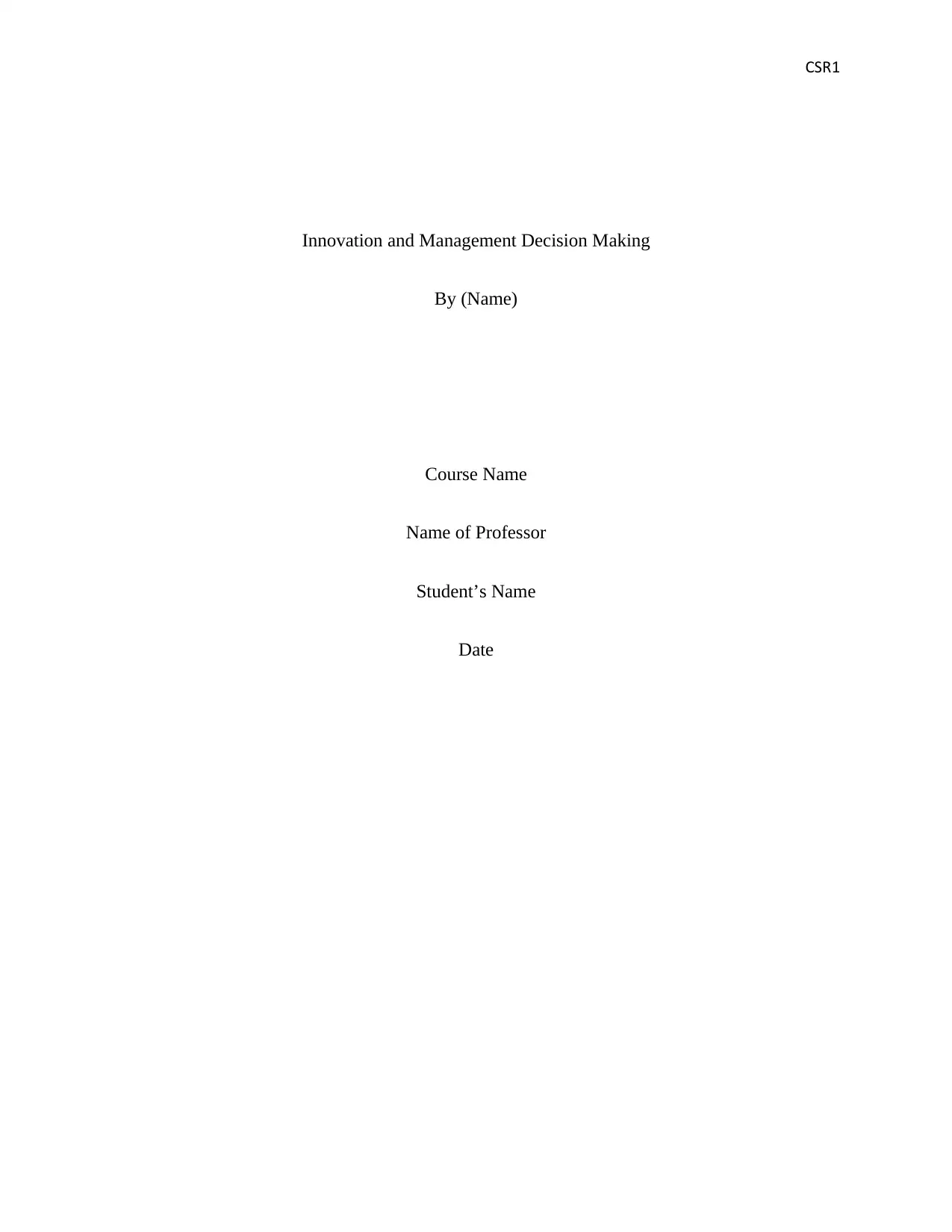
CSR1
Innovation and Management Decision Making
By (Name)
Course Name
Name of Professor
Student’s Name
Date
Innovation and Management Decision Making
By (Name)
Course Name
Name of Professor
Student’s Name
Date
Paraphrase This Document
Need a fresh take? Get an instant paraphrase of this document with our AI Paraphraser
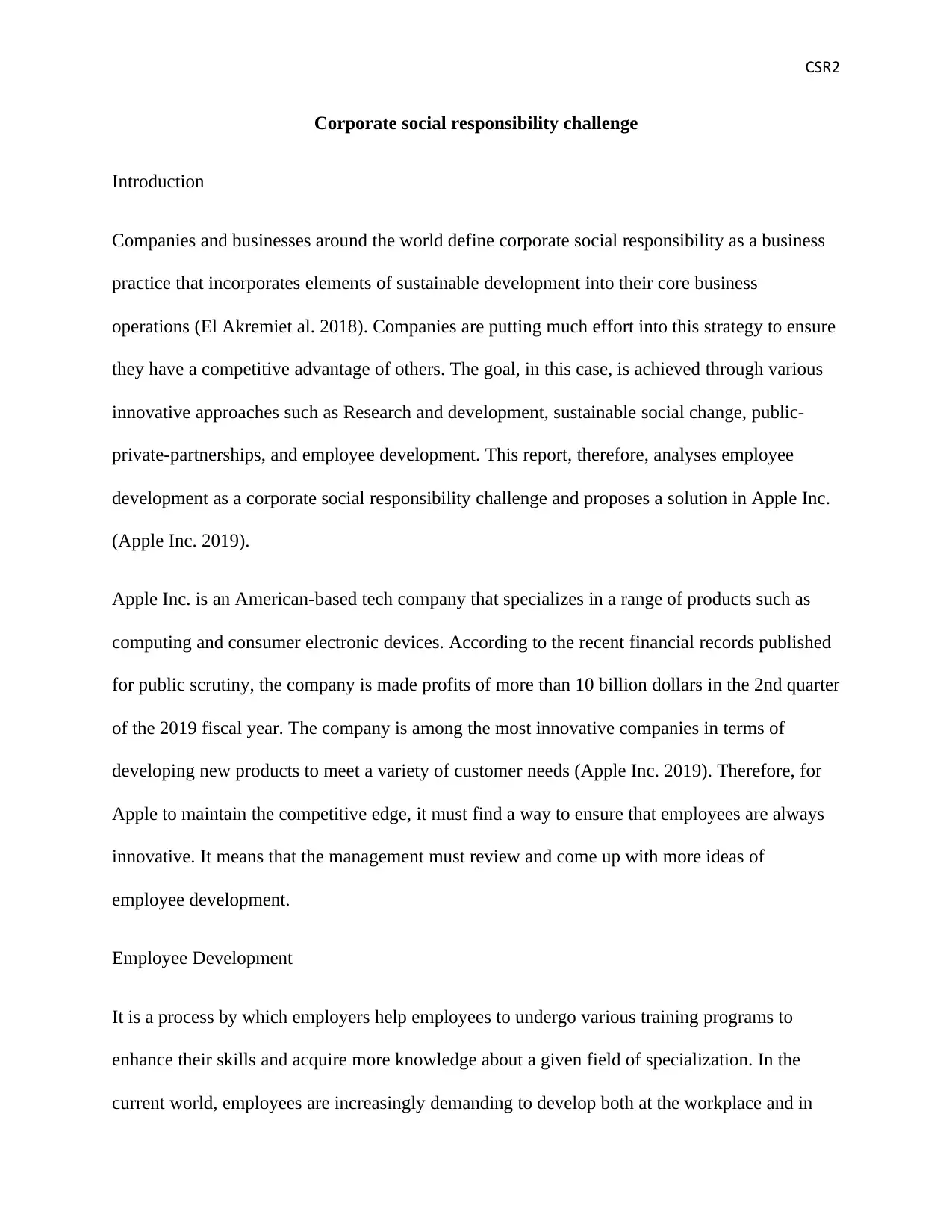
CSR2
Corporate social responsibility challenge
Introduction
Companies and businesses around the world define corporate social responsibility as a business
practice that incorporates elements of sustainable development into their core business
operations (El Akremiet al. 2018). Companies are putting much effort into this strategy to ensure
they have a competitive advantage of others. The goal, in this case, is achieved through various
innovative approaches such as Research and development, sustainable social change, public-
private-partnerships, and employee development. This report, therefore, analyses employee
development as a corporate social responsibility challenge and proposes a solution in Apple Inc.
(Apple Inc. 2019).
Apple Inc. is an American-based tech company that specializes in a range of products such as
computing and consumer electronic devices. According to the recent financial records published
for public scrutiny, the company is made profits of more than 10 billion dollars in the 2nd quarter
of the 2019 fiscal year. The company is among the most innovative companies in terms of
developing new products to meet a variety of customer needs (Apple Inc. 2019). Therefore, for
Apple to maintain the competitive edge, it must find a way to ensure that employees are always
innovative. It means that the management must review and come up with more ideas of
employee development.
Employee Development
It is a process by which employers help employees to undergo various training programs to
enhance their skills and acquire more knowledge about a given field of specialization. In the
current world, employees are increasingly demanding to develop both at the workplace and in
Corporate social responsibility challenge
Introduction
Companies and businesses around the world define corporate social responsibility as a business
practice that incorporates elements of sustainable development into their core business
operations (El Akremiet al. 2018). Companies are putting much effort into this strategy to ensure
they have a competitive advantage of others. The goal, in this case, is achieved through various
innovative approaches such as Research and development, sustainable social change, public-
private-partnerships, and employee development. This report, therefore, analyses employee
development as a corporate social responsibility challenge and proposes a solution in Apple Inc.
(Apple Inc. 2019).
Apple Inc. is an American-based tech company that specializes in a range of products such as
computing and consumer electronic devices. According to the recent financial records published
for public scrutiny, the company is made profits of more than 10 billion dollars in the 2nd quarter
of the 2019 fiscal year. The company is among the most innovative companies in terms of
developing new products to meet a variety of customer needs (Apple Inc. 2019). Therefore, for
Apple to maintain the competitive edge, it must find a way to ensure that employees are always
innovative. It means that the management must review and come up with more ideas of
employee development.
Employee Development
It is a process by which employers help employees to undergo various training programs to
enhance their skills and acquire more knowledge about a given field of specialization. In the
current world, employees are increasingly demanding to develop both at the workplace and in
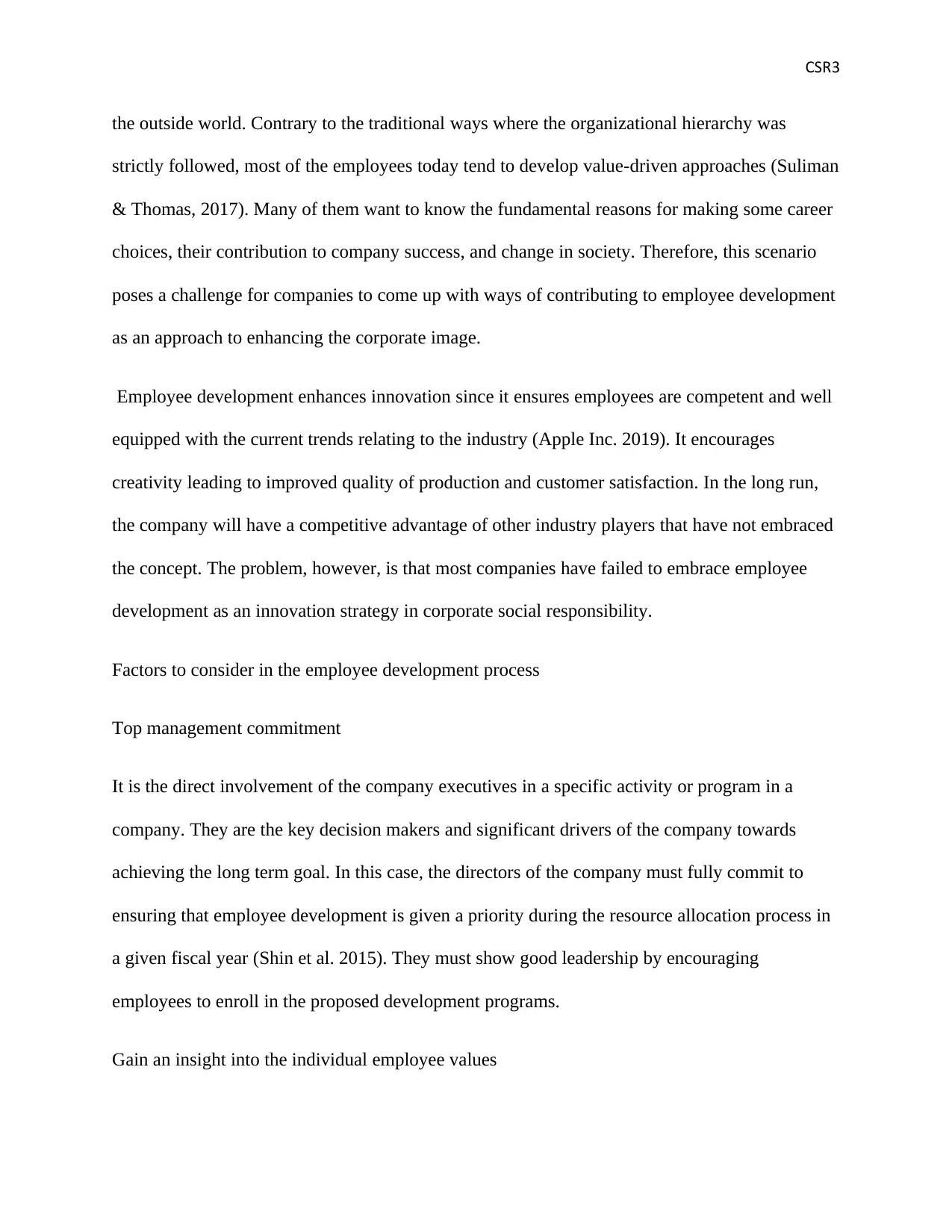
CSR3
the outside world. Contrary to the traditional ways where the organizational hierarchy was
strictly followed, most of the employees today tend to develop value-driven approaches (Suliman
& Thomas, 2017). Many of them want to know the fundamental reasons for making some career
choices, their contribution to company success, and change in society. Therefore, this scenario
poses a challenge for companies to come up with ways of contributing to employee development
as an approach to enhancing the corporate image.
Employee development enhances innovation since it ensures employees are competent and well
equipped with the current trends relating to the industry (Apple Inc. 2019). It encourages
creativity leading to improved quality of production and customer satisfaction. In the long run,
the company will have a competitive advantage of other industry players that have not embraced
the concept. The problem, however, is that most companies have failed to embrace employee
development as an innovation strategy in corporate social responsibility.
Factors to consider in the employee development process
Top management commitment
It is the direct involvement of the company executives in a specific activity or program in a
company. They are the key decision makers and significant drivers of the company towards
achieving the long term goal. In this case, the directors of the company must fully commit to
ensuring that employee development is given a priority during the resource allocation process in
a given fiscal year (Shin et al. 2015). They must show good leadership by encouraging
employees to enroll in the proposed development programs.
Gain an insight into the individual employee values
the outside world. Contrary to the traditional ways where the organizational hierarchy was
strictly followed, most of the employees today tend to develop value-driven approaches (Suliman
& Thomas, 2017). Many of them want to know the fundamental reasons for making some career
choices, their contribution to company success, and change in society. Therefore, this scenario
poses a challenge for companies to come up with ways of contributing to employee development
as an approach to enhancing the corporate image.
Employee development enhances innovation since it ensures employees are competent and well
equipped with the current trends relating to the industry (Apple Inc. 2019). It encourages
creativity leading to improved quality of production and customer satisfaction. In the long run,
the company will have a competitive advantage of other industry players that have not embraced
the concept. The problem, however, is that most companies have failed to embrace employee
development as an innovation strategy in corporate social responsibility.
Factors to consider in the employee development process
Top management commitment
It is the direct involvement of the company executives in a specific activity or program in a
company. They are the key decision makers and significant drivers of the company towards
achieving the long term goal. In this case, the directors of the company must fully commit to
ensuring that employee development is given a priority during the resource allocation process in
a given fiscal year (Shin et al. 2015). They must show good leadership by encouraging
employees to enroll in the proposed development programs.
Gain an insight into the individual employee values
⊘ This is a preview!⊘
Do you want full access?
Subscribe today to unlock all pages.

Trusted by 1+ million students worldwide
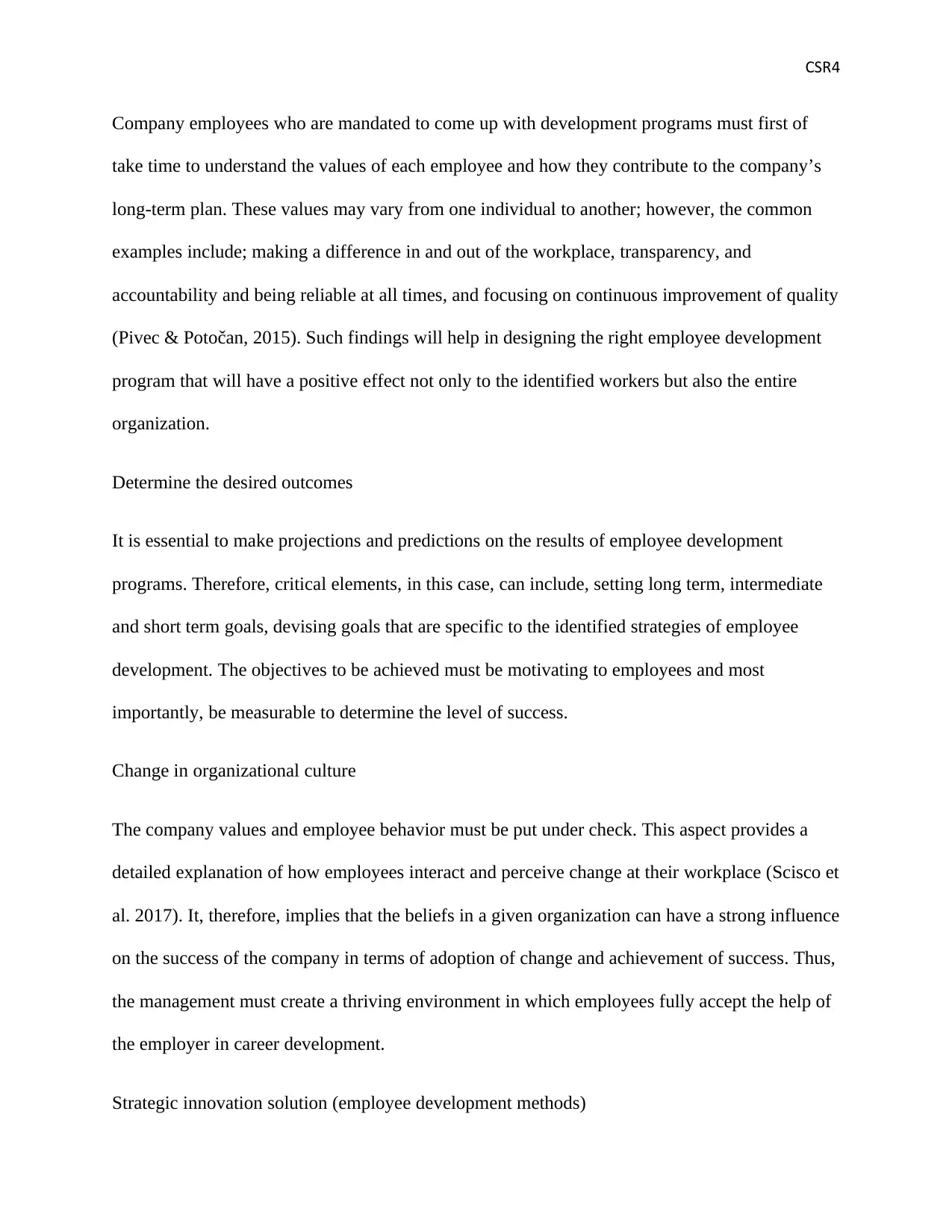
CSR4
Company employees who are mandated to come up with development programs must first of
take time to understand the values of each employee and how they contribute to the company’s
long-term plan. These values may vary from one individual to another; however, the common
examples include; making a difference in and out of the workplace, transparency, and
accountability and being reliable at all times, and focusing on continuous improvement of quality
(Pivec & Potočan, 2015). Such findings will help in designing the right employee development
program that will have a positive effect not only to the identified workers but also the entire
organization.
Determine the desired outcomes
It is essential to make projections and predictions on the results of employee development
programs. Therefore, critical elements, in this case, can include, setting long term, intermediate
and short term goals, devising goals that are specific to the identified strategies of employee
development. The objectives to be achieved must be motivating to employees and most
importantly, be measurable to determine the level of success.
Change in organizational culture
The company values and employee behavior must be put under check. This aspect provides a
detailed explanation of how employees interact and perceive change at their workplace (Scisco et
al. 2017). It, therefore, implies that the beliefs in a given organization can have a strong influence
on the success of the company in terms of adoption of change and achievement of success. Thus,
the management must create a thriving environment in which employees fully accept the help of
the employer in career development.
Strategic innovation solution (employee development methods)
Company employees who are mandated to come up with development programs must first of
take time to understand the values of each employee and how they contribute to the company’s
long-term plan. These values may vary from one individual to another; however, the common
examples include; making a difference in and out of the workplace, transparency, and
accountability and being reliable at all times, and focusing on continuous improvement of quality
(Pivec & Potočan, 2015). Such findings will help in designing the right employee development
program that will have a positive effect not only to the identified workers but also the entire
organization.
Determine the desired outcomes
It is essential to make projections and predictions on the results of employee development
programs. Therefore, critical elements, in this case, can include, setting long term, intermediate
and short term goals, devising goals that are specific to the identified strategies of employee
development. The objectives to be achieved must be motivating to employees and most
importantly, be measurable to determine the level of success.
Change in organizational culture
The company values and employee behavior must be put under check. This aspect provides a
detailed explanation of how employees interact and perceive change at their workplace (Scisco et
al. 2017). It, therefore, implies that the beliefs in a given organization can have a strong influence
on the success of the company in terms of adoption of change and achievement of success. Thus,
the management must create a thriving environment in which employees fully accept the help of
the employer in career development.
Strategic innovation solution (employee development methods)
Paraphrase This Document
Need a fresh take? Get an instant paraphrase of this document with our AI Paraphraser
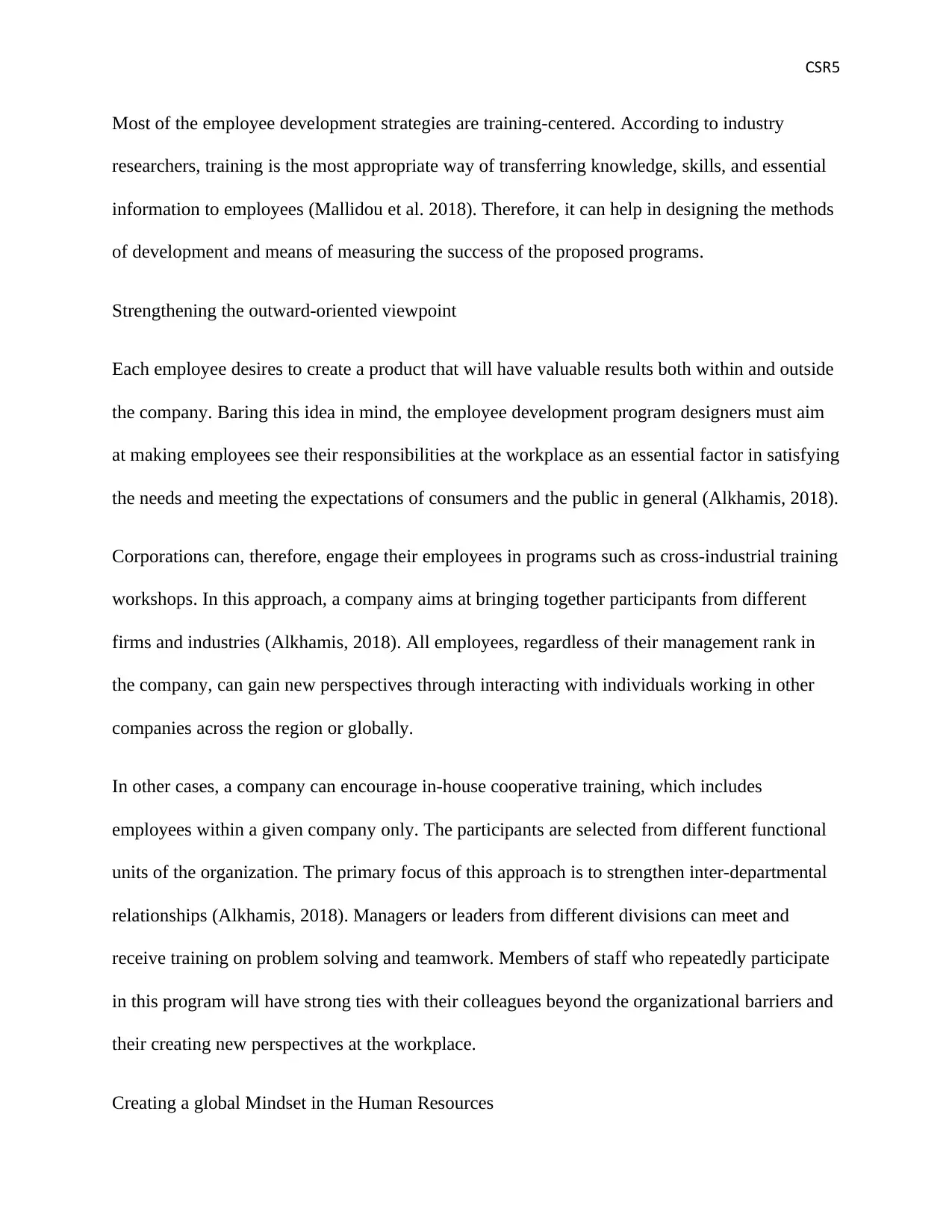
CSR5
Most of the employee development strategies are training-centered. According to industry
researchers, training is the most appropriate way of transferring knowledge, skills, and essential
information to employees (Mallidou et al. 2018). Therefore, it can help in designing the methods
of development and means of measuring the success of the proposed programs.
Strengthening the outward-oriented viewpoint
Each employee desires to create a product that will have valuable results both within and outside
the company. Baring this idea in mind, the employee development program designers must aim
at making employees see their responsibilities at the workplace as an essential factor in satisfying
the needs and meeting the expectations of consumers and the public in general (Alkhamis, 2018).
Corporations can, therefore, engage their employees in programs such as cross-industrial training
workshops. In this approach, a company aims at bringing together participants from different
firms and industries (Alkhamis, 2018). All employees, regardless of their management rank in
the company, can gain new perspectives through interacting with individuals working in other
companies across the region or globally.
In other cases, a company can encourage in-house cooperative training, which includes
employees within a given company only. The participants are selected from different functional
units of the organization. The primary focus of this approach is to strengthen inter-departmental
relationships (Alkhamis, 2018). Managers or leaders from different divisions can meet and
receive training on problem solving and teamwork. Members of staff who repeatedly participate
in this program will have strong ties with their colleagues beyond the organizational barriers and
their creating new perspectives at the workplace.
Creating a global Mindset in the Human Resources
Most of the employee development strategies are training-centered. According to industry
researchers, training is the most appropriate way of transferring knowledge, skills, and essential
information to employees (Mallidou et al. 2018). Therefore, it can help in designing the methods
of development and means of measuring the success of the proposed programs.
Strengthening the outward-oriented viewpoint
Each employee desires to create a product that will have valuable results both within and outside
the company. Baring this idea in mind, the employee development program designers must aim
at making employees see their responsibilities at the workplace as an essential factor in satisfying
the needs and meeting the expectations of consumers and the public in general (Alkhamis, 2018).
Corporations can, therefore, engage their employees in programs such as cross-industrial training
workshops. In this approach, a company aims at bringing together participants from different
firms and industries (Alkhamis, 2018). All employees, regardless of their management rank in
the company, can gain new perspectives through interacting with individuals working in other
companies across the region or globally.
In other cases, a company can encourage in-house cooperative training, which includes
employees within a given company only. The participants are selected from different functional
units of the organization. The primary focus of this approach is to strengthen inter-departmental
relationships (Alkhamis, 2018). Managers or leaders from different divisions can meet and
receive training on problem solving and teamwork. Members of staff who repeatedly participate
in this program will have strong ties with their colleagues beyond the organizational barriers and
their creating new perspectives at the workplace.
Creating a global Mindset in the Human Resources
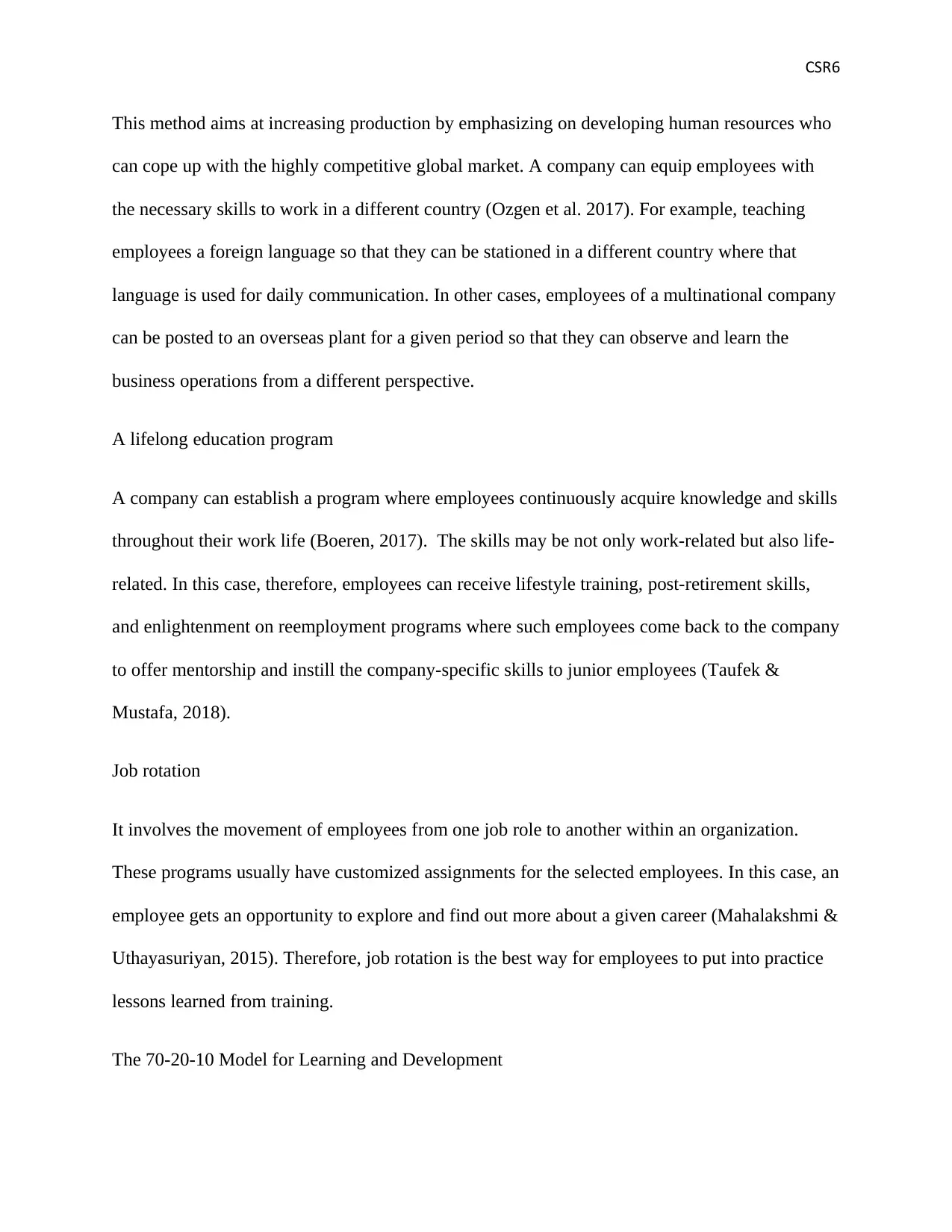
CSR6
This method aims at increasing production by emphasizing on developing human resources who
can cope up with the highly competitive global market. A company can equip employees with
the necessary skills to work in a different country (Ozgen et al. 2017). For example, teaching
employees a foreign language so that they can be stationed in a different country where that
language is used for daily communication. In other cases, employees of a multinational company
can be posted to an overseas plant for a given period so that they can observe and learn the
business operations from a different perspective.
A lifelong education program
A company can establish a program where employees continuously acquire knowledge and skills
throughout their work life (Boeren, 2017). The skills may be not only work-related but also life-
related. In this case, therefore, employees can receive lifestyle training, post-retirement skills,
and enlightenment on reemployment programs where such employees come back to the company
to offer mentorship and instill the company-specific skills to junior employees (Taufek &
Mustafa, 2018).
Job rotation
It involves the movement of employees from one job role to another within an organization.
These programs usually have customized assignments for the selected employees. In this case, an
employee gets an opportunity to explore and find out more about a given career (Mahalakshmi &
Uthayasuriyan, 2015). Therefore, job rotation is the best way for employees to put into practice
lessons learned from training.
The 70-20-10 Model for Learning and Development
This method aims at increasing production by emphasizing on developing human resources who
can cope up with the highly competitive global market. A company can equip employees with
the necessary skills to work in a different country (Ozgen et al. 2017). For example, teaching
employees a foreign language so that they can be stationed in a different country where that
language is used for daily communication. In other cases, employees of a multinational company
can be posted to an overseas plant for a given period so that they can observe and learn the
business operations from a different perspective.
A lifelong education program
A company can establish a program where employees continuously acquire knowledge and skills
throughout their work life (Boeren, 2017). The skills may be not only work-related but also life-
related. In this case, therefore, employees can receive lifestyle training, post-retirement skills,
and enlightenment on reemployment programs where such employees come back to the company
to offer mentorship and instill the company-specific skills to junior employees (Taufek &
Mustafa, 2018).
Job rotation
It involves the movement of employees from one job role to another within an organization.
These programs usually have customized assignments for the selected employees. In this case, an
employee gets an opportunity to explore and find out more about a given career (Mahalakshmi &
Uthayasuriyan, 2015). Therefore, job rotation is the best way for employees to put into practice
lessons learned from training.
The 70-20-10 Model for Learning and Development
⊘ This is a preview!⊘
Do you want full access?
Subscribe today to unlock all pages.

Trusted by 1+ million students worldwide
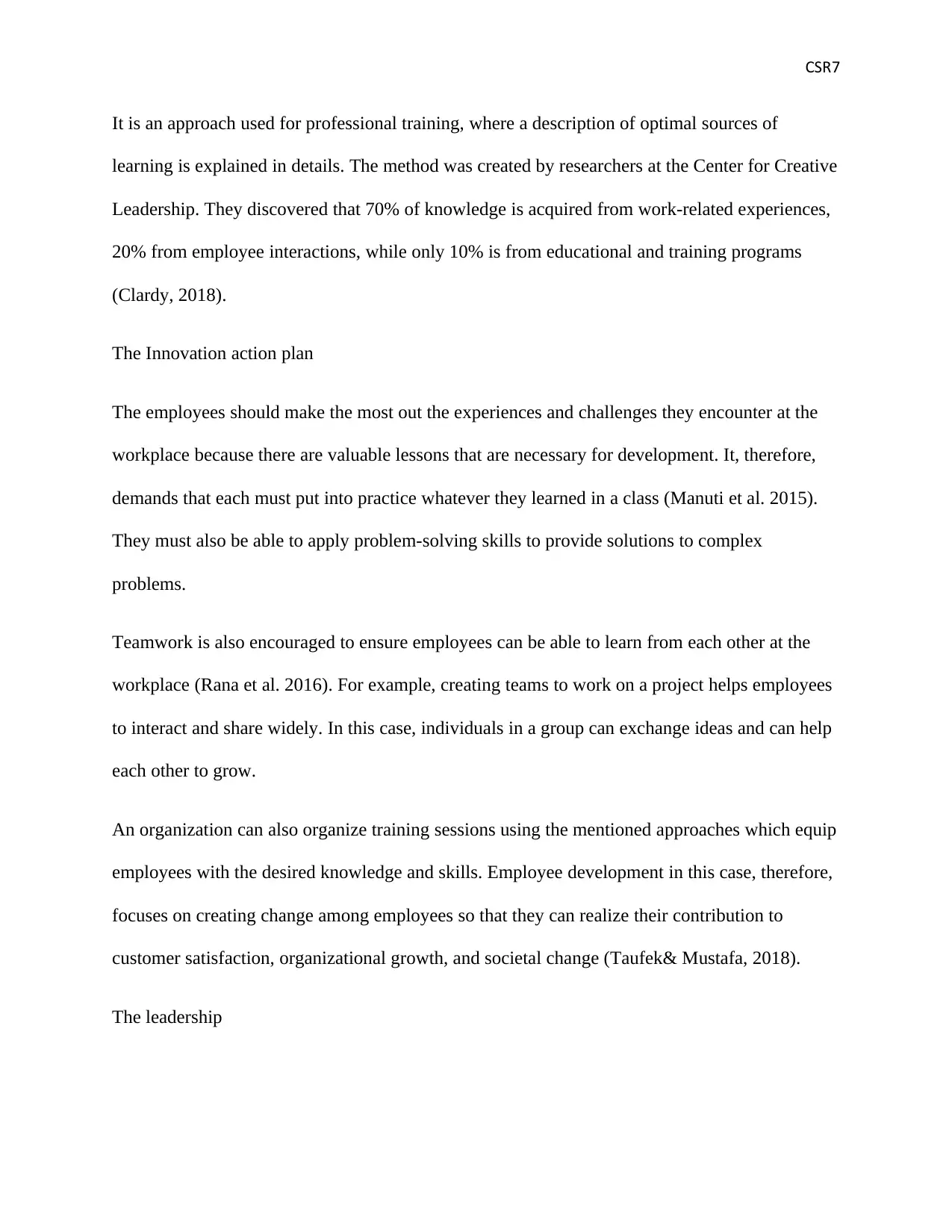
CSR7
It is an approach used for professional training, where a description of optimal sources of
learning is explained in details. The method was created by researchers at the Center for Creative
Leadership. They discovered that 70% of knowledge is acquired from work-related experiences,
20% from employee interactions, while only 10% is from educational and training programs
(Clardy, 2018).
The Innovation action plan
The employees should make the most out the experiences and challenges they encounter at the
workplace because there are valuable lessons that are necessary for development. It, therefore,
demands that each must put into practice whatever they learned in a class (Manuti et al. 2015).
They must also be able to apply problem-solving skills to provide solutions to complex
problems.
Teamwork is also encouraged to ensure employees can be able to learn from each other at the
workplace (Rana et al. 2016). For example, creating teams to work on a project helps employees
to interact and share widely. In this case, individuals in a group can exchange ideas and can help
each other to grow.
An organization can also organize training sessions using the mentioned approaches which equip
employees with the desired knowledge and skills. Employee development in this case, therefore,
focuses on creating change among employees so that they can realize their contribution to
customer satisfaction, organizational growth, and societal change (Taufek& Mustafa, 2018).
The leadership
It is an approach used for professional training, where a description of optimal sources of
learning is explained in details. The method was created by researchers at the Center for Creative
Leadership. They discovered that 70% of knowledge is acquired from work-related experiences,
20% from employee interactions, while only 10% is from educational and training programs
(Clardy, 2018).
The Innovation action plan
The employees should make the most out the experiences and challenges they encounter at the
workplace because there are valuable lessons that are necessary for development. It, therefore,
demands that each must put into practice whatever they learned in a class (Manuti et al. 2015).
They must also be able to apply problem-solving skills to provide solutions to complex
problems.
Teamwork is also encouraged to ensure employees can be able to learn from each other at the
workplace (Rana et al. 2016). For example, creating teams to work on a project helps employees
to interact and share widely. In this case, individuals in a group can exchange ideas and can help
each other to grow.
An organization can also organize training sessions using the mentioned approaches which equip
employees with the desired knowledge and skills. Employee development in this case, therefore,
focuses on creating change among employees so that they can realize their contribution to
customer satisfaction, organizational growth, and societal change (Taufek& Mustafa, 2018).
The leadership
Paraphrase This Document
Need a fresh take? Get an instant paraphrase of this document with our AI Paraphraser
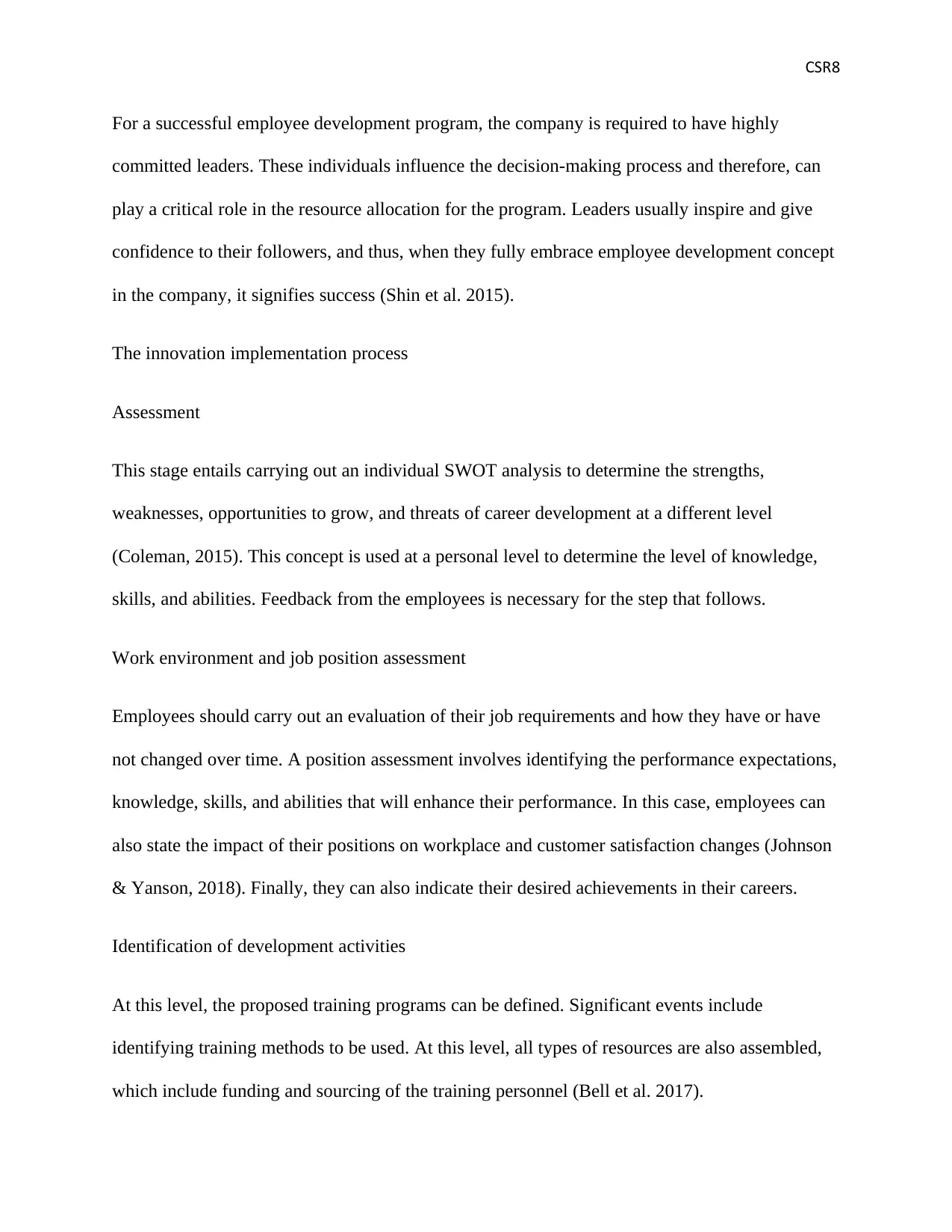
CSR8
For a successful employee development program, the company is required to have highly
committed leaders. These individuals influence the decision-making process and therefore, can
play a critical role in the resource allocation for the program. Leaders usually inspire and give
confidence to their followers, and thus, when they fully embrace employee development concept
in the company, it signifies success (Shin et al. 2015).
The innovation implementation process
Assessment
This stage entails carrying out an individual SWOT analysis to determine the strengths,
weaknesses, opportunities to grow, and threats of career development at a different level
(Coleman, 2015). This concept is used at a personal level to determine the level of knowledge,
skills, and abilities. Feedback from the employees is necessary for the step that follows.
Work environment and job position assessment
Employees should carry out an evaluation of their job requirements and how they have or have
not changed over time. A position assessment involves identifying the performance expectations,
knowledge, skills, and abilities that will enhance their performance. In this case, employees can
also state the impact of their positions on workplace and customer satisfaction changes (Johnson
& Yanson, 2018). Finally, they can also indicate their desired achievements in their careers.
Identification of development activities
At this level, the proposed training programs can be defined. Significant events include
identifying training methods to be used. At this level, all types of resources are also assembled,
which include funding and sourcing of the training personnel (Bell et al. 2017).
For a successful employee development program, the company is required to have highly
committed leaders. These individuals influence the decision-making process and therefore, can
play a critical role in the resource allocation for the program. Leaders usually inspire and give
confidence to their followers, and thus, when they fully embrace employee development concept
in the company, it signifies success (Shin et al. 2015).
The innovation implementation process
Assessment
This stage entails carrying out an individual SWOT analysis to determine the strengths,
weaknesses, opportunities to grow, and threats of career development at a different level
(Coleman, 2015). This concept is used at a personal level to determine the level of knowledge,
skills, and abilities. Feedback from the employees is necessary for the step that follows.
Work environment and job position assessment
Employees should carry out an evaluation of their job requirements and how they have or have
not changed over time. A position assessment involves identifying the performance expectations,
knowledge, skills, and abilities that will enhance their performance. In this case, employees can
also state the impact of their positions on workplace and customer satisfaction changes (Johnson
& Yanson, 2018). Finally, they can also indicate their desired achievements in their careers.
Identification of development activities
At this level, the proposed training programs can be defined. Significant events include
identifying training methods to be used. At this level, all types of resources are also assembled,
which include funding and sourcing of the training personnel (Bell et al. 2017).
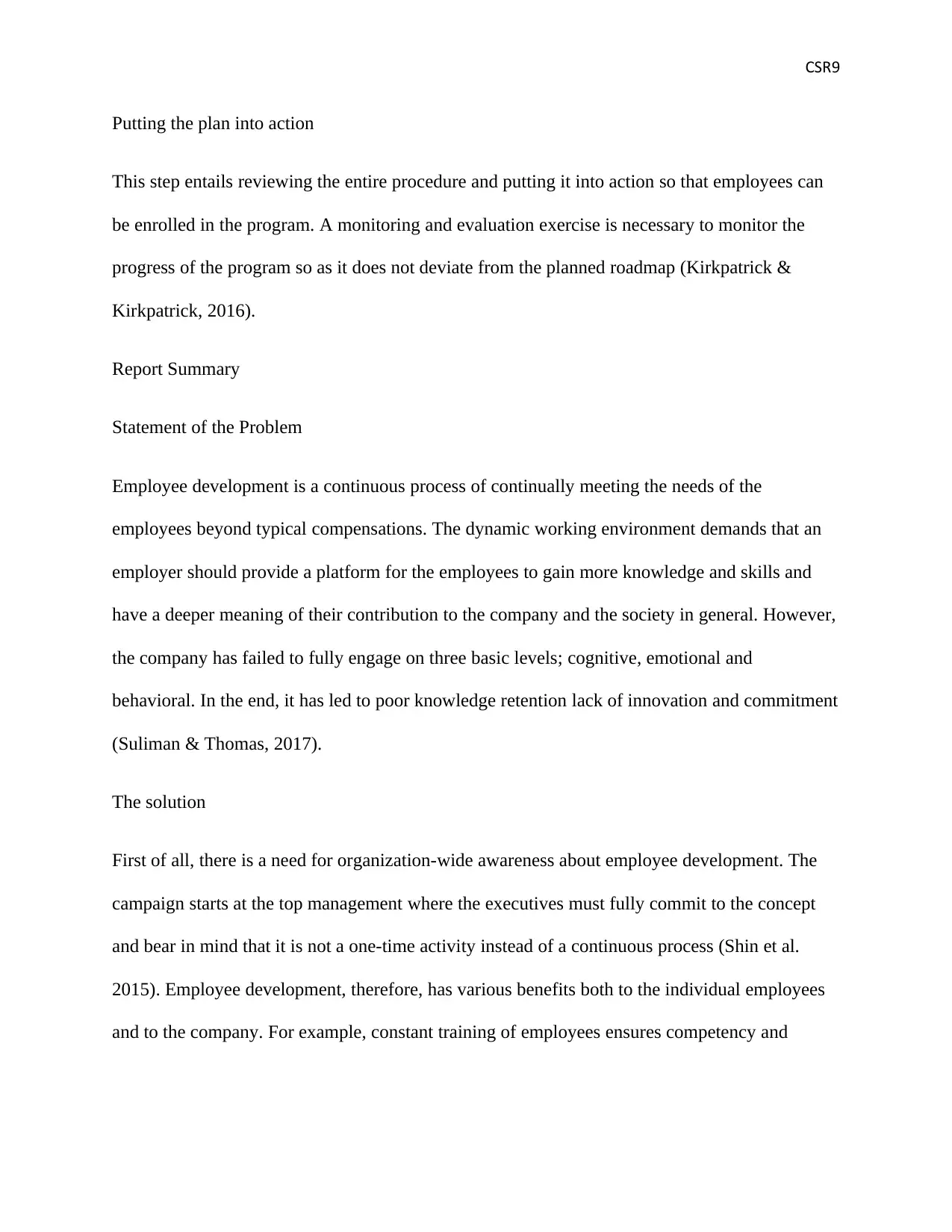
CSR9
Putting the plan into action
This step entails reviewing the entire procedure and putting it into action so that employees can
be enrolled in the program. A monitoring and evaluation exercise is necessary to monitor the
progress of the program so as it does not deviate from the planned roadmap (Kirkpatrick &
Kirkpatrick, 2016).
Report Summary
Statement of the Problem
Employee development is a continuous process of continually meeting the needs of the
employees beyond typical compensations. The dynamic working environment demands that an
employer should provide a platform for the employees to gain more knowledge and skills and
have a deeper meaning of their contribution to the company and the society in general. However,
the company has failed to fully engage on three basic levels; cognitive, emotional and
behavioral. In the end, it has led to poor knowledge retention lack of innovation and commitment
(Suliman & Thomas, 2017).
The solution
First of all, there is a need for organization-wide awareness about employee development. The
campaign starts at the top management where the executives must fully commit to the concept
and bear in mind that it is not a one-time activity instead of a continuous process (Shin et al.
2015). Employee development, therefore, has various benefits both to the individual employees
and to the company. For example, constant training of employees ensures competency and
Putting the plan into action
This step entails reviewing the entire procedure and putting it into action so that employees can
be enrolled in the program. A monitoring and evaluation exercise is necessary to monitor the
progress of the program so as it does not deviate from the planned roadmap (Kirkpatrick &
Kirkpatrick, 2016).
Report Summary
Statement of the Problem
Employee development is a continuous process of continually meeting the needs of the
employees beyond typical compensations. The dynamic working environment demands that an
employer should provide a platform for the employees to gain more knowledge and skills and
have a deeper meaning of their contribution to the company and the society in general. However,
the company has failed to fully engage on three basic levels; cognitive, emotional and
behavioral. In the end, it has led to poor knowledge retention lack of innovation and commitment
(Suliman & Thomas, 2017).
The solution
First of all, there is a need for organization-wide awareness about employee development. The
campaign starts at the top management where the executives must fully commit to the concept
and bear in mind that it is not a one-time activity instead of a continuous process (Shin et al.
2015). Employee development, therefore, has various benefits both to the individual employees
and to the company. For example, constant training of employees ensures competency and
⊘ This is a preview!⊘
Do you want full access?
Subscribe today to unlock all pages.

Trusted by 1+ million students worldwide
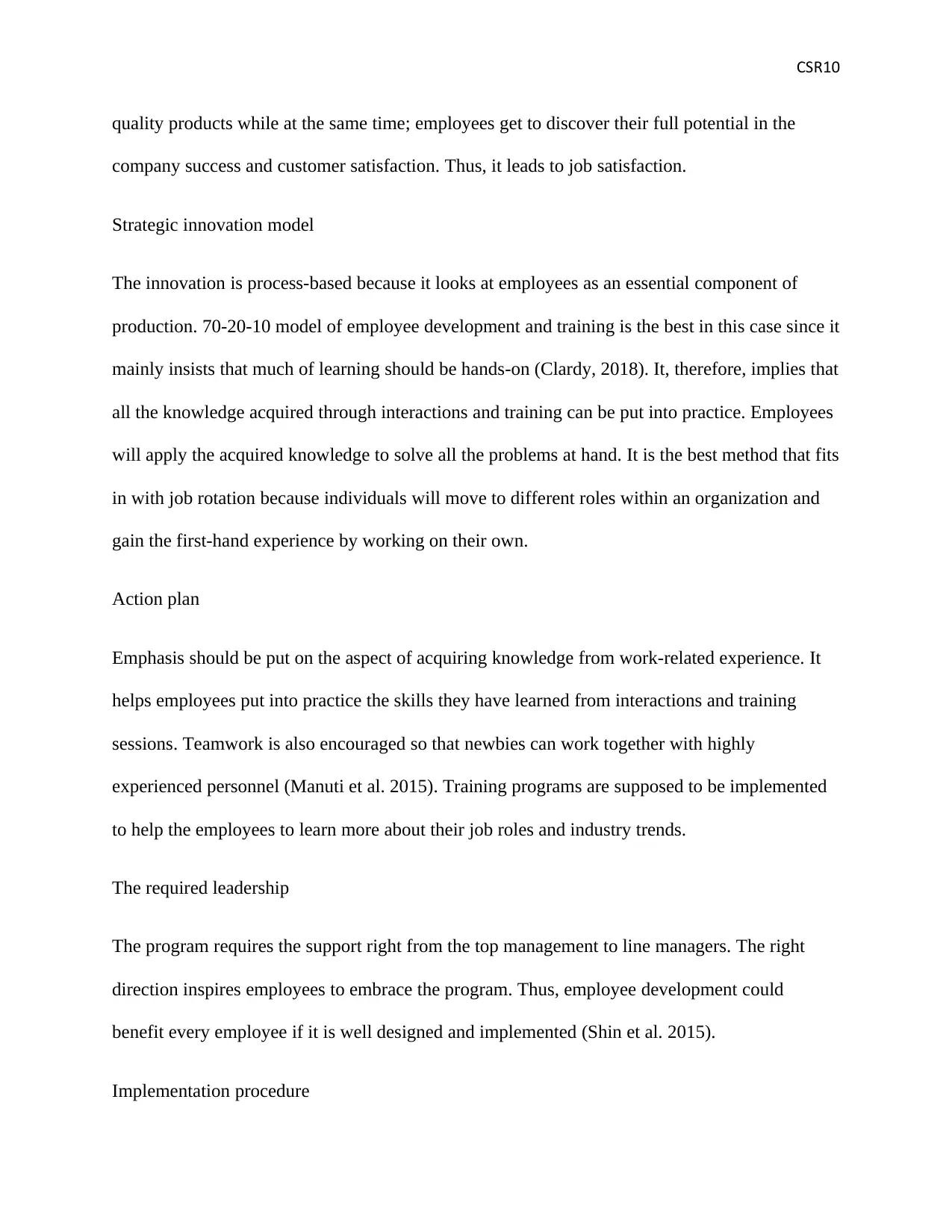
CSR10
quality products while at the same time; employees get to discover their full potential in the
company success and customer satisfaction. Thus, it leads to job satisfaction.
Strategic innovation model
The innovation is process-based because it looks at employees as an essential component of
production. 70-20-10 model of employee development and training is the best in this case since it
mainly insists that much of learning should be hands-on (Clardy, 2018). It, therefore, implies that
all the knowledge acquired through interactions and training can be put into practice. Employees
will apply the acquired knowledge to solve all the problems at hand. It is the best method that fits
in with job rotation because individuals will move to different roles within an organization and
gain the first-hand experience by working on their own.
Action plan
Emphasis should be put on the aspect of acquiring knowledge from work-related experience. It
helps employees put into practice the skills they have learned from interactions and training
sessions. Teamwork is also encouraged so that newbies can work together with highly
experienced personnel (Manuti et al. 2015). Training programs are supposed to be implemented
to help the employees to learn more about their job roles and industry trends.
The required leadership
The program requires the support right from the top management to line managers. The right
direction inspires employees to embrace the program. Thus, employee development could
benefit every employee if it is well designed and implemented (Shin et al. 2015).
Implementation procedure
quality products while at the same time; employees get to discover their full potential in the
company success and customer satisfaction. Thus, it leads to job satisfaction.
Strategic innovation model
The innovation is process-based because it looks at employees as an essential component of
production. 70-20-10 model of employee development and training is the best in this case since it
mainly insists that much of learning should be hands-on (Clardy, 2018). It, therefore, implies that
all the knowledge acquired through interactions and training can be put into practice. Employees
will apply the acquired knowledge to solve all the problems at hand. It is the best method that fits
in with job rotation because individuals will move to different roles within an organization and
gain the first-hand experience by working on their own.
Action plan
Emphasis should be put on the aspect of acquiring knowledge from work-related experience. It
helps employees put into practice the skills they have learned from interactions and training
sessions. Teamwork is also encouraged so that newbies can work together with highly
experienced personnel (Manuti et al. 2015). Training programs are supposed to be implemented
to help the employees to learn more about their job roles and industry trends.
The required leadership
The program requires the support right from the top management to line managers. The right
direction inspires employees to embrace the program. Thus, employee development could
benefit every employee if it is well designed and implemented (Shin et al. 2015).
Implementation procedure
Paraphrase This Document
Need a fresh take? Get an instant paraphrase of this document with our AI Paraphraser
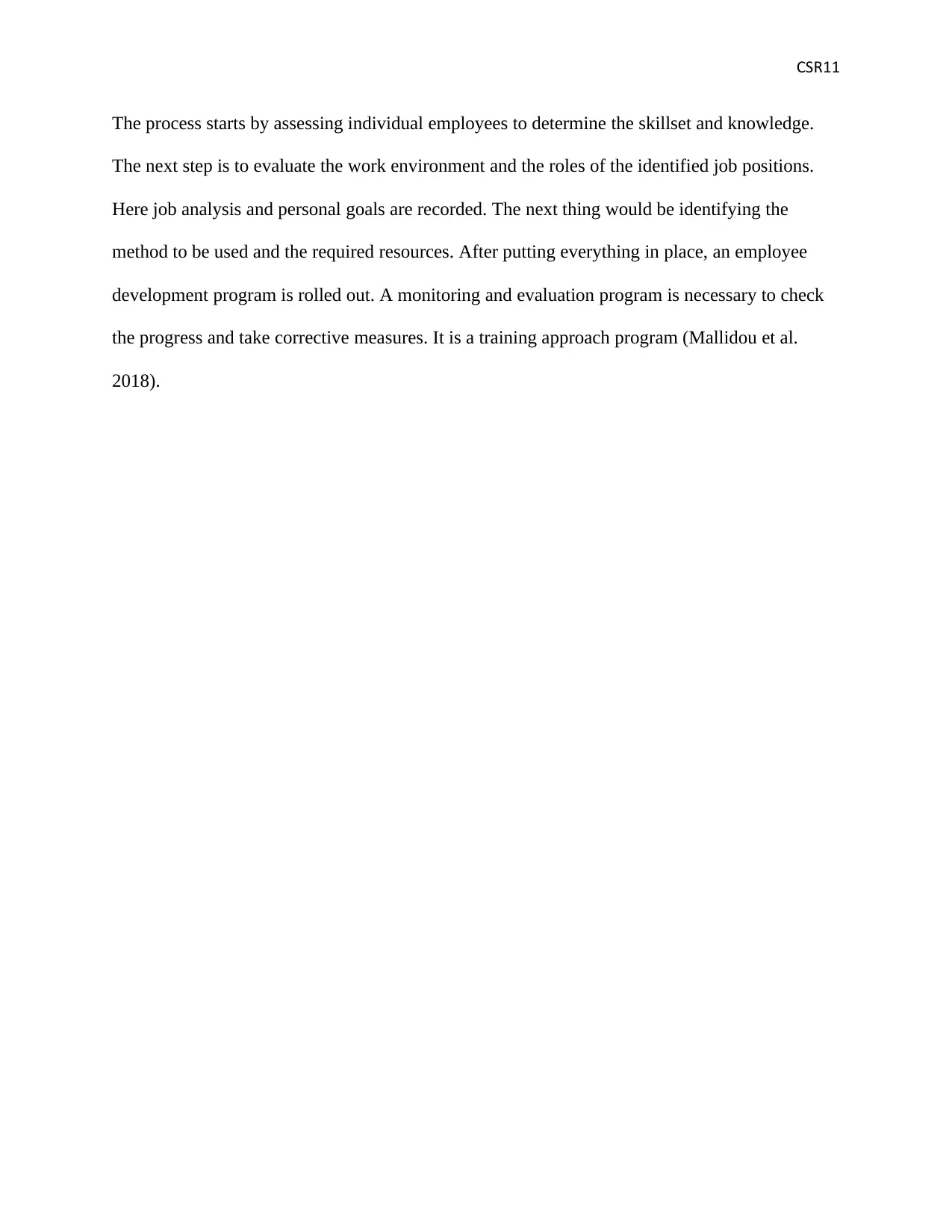
CSR11
The process starts by assessing individual employees to determine the skillset and knowledge.
The next step is to evaluate the work environment and the roles of the identified job positions.
Here job analysis and personal goals are recorded. The next thing would be identifying the
method to be used and the required resources. After putting everything in place, an employee
development program is rolled out. A monitoring and evaluation program is necessary to check
the progress and take corrective measures. It is a training approach program (Mallidou et al.
2018).
The process starts by assessing individual employees to determine the skillset and knowledge.
The next step is to evaluate the work environment and the roles of the identified job positions.
Here job analysis and personal goals are recorded. The next thing would be identifying the
method to be used and the required resources. After putting everything in place, an employee
development program is rolled out. A monitoring and evaluation program is necessary to check
the progress and take corrective measures. It is a training approach program (Mallidou et al.
2018).
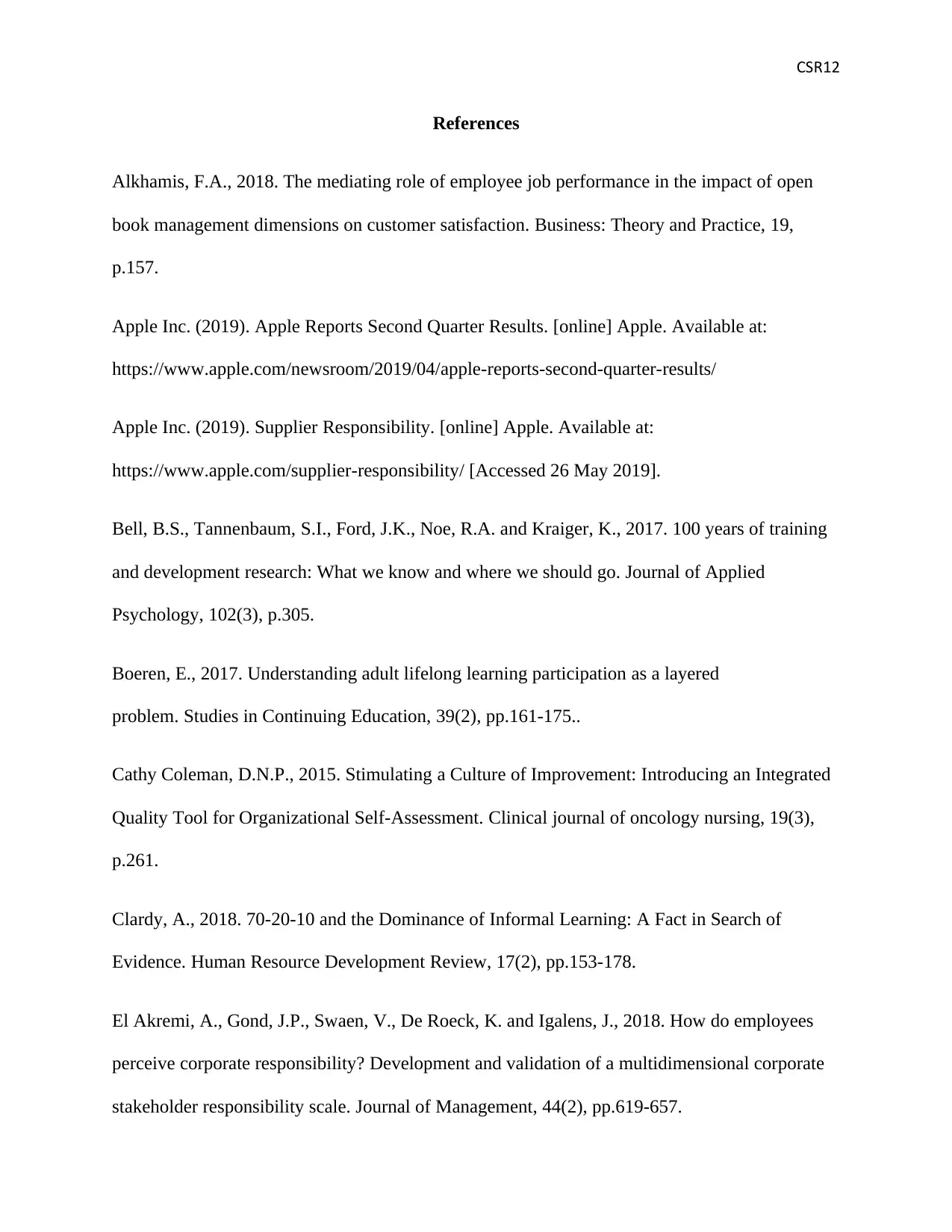
CSR12
References
Alkhamis, F.A., 2018. The mediating role of employee job performance in the impact of open
book management dimensions on customer satisfaction. Business: Theory and Practice, 19,
p.157.
Apple Inc. (2019). Apple Reports Second Quarter Results. [online] Apple. Available at:
https://www.apple.com/newsroom/2019/04/apple-reports-second-quarter-results/
Apple Inc. (2019). Supplier Responsibility. [online] Apple. Available at:
https://www.apple.com/supplier-responsibility/ [Accessed 26 May 2019].
Bell, B.S., Tannenbaum, S.I., Ford, J.K., Noe, R.A. and Kraiger, K., 2017. 100 years of training
and development research: What we know and where we should go. Journal of Applied
Psychology, 102(3), p.305.
Boeren, E., 2017. Understanding adult lifelong learning participation as a layered
problem. Studies in Continuing Education, 39(2), pp.161-175..
Cathy Coleman, D.N.P., 2015. Stimulating a Culture of Improvement: Introducing an Integrated
Quality Tool for Organizational Self-Assessment. Clinical journal of oncology nursing, 19(3),
p.261.
Clardy, A., 2018. 70-20-10 and the Dominance of Informal Learning: A Fact in Search of
Evidence. Human Resource Development Review, 17(2), pp.153-178.
El Akremi, A., Gond, J.P., Swaen, V., De Roeck, K. and Igalens, J., 2018. How do employees
perceive corporate responsibility? Development and validation of a multidimensional corporate
stakeholder responsibility scale. Journal of Management, 44(2), pp.619-657.
References
Alkhamis, F.A., 2018. The mediating role of employee job performance in the impact of open
book management dimensions on customer satisfaction. Business: Theory and Practice, 19,
p.157.
Apple Inc. (2019). Apple Reports Second Quarter Results. [online] Apple. Available at:
https://www.apple.com/newsroom/2019/04/apple-reports-second-quarter-results/
Apple Inc. (2019). Supplier Responsibility. [online] Apple. Available at:
https://www.apple.com/supplier-responsibility/ [Accessed 26 May 2019].
Bell, B.S., Tannenbaum, S.I., Ford, J.K., Noe, R.A. and Kraiger, K., 2017. 100 years of training
and development research: What we know and where we should go. Journal of Applied
Psychology, 102(3), p.305.
Boeren, E., 2017. Understanding adult lifelong learning participation as a layered
problem. Studies in Continuing Education, 39(2), pp.161-175..
Cathy Coleman, D.N.P., 2015. Stimulating a Culture of Improvement: Introducing an Integrated
Quality Tool for Organizational Self-Assessment. Clinical journal of oncology nursing, 19(3),
p.261.
Clardy, A., 2018. 70-20-10 and the Dominance of Informal Learning: A Fact in Search of
Evidence. Human Resource Development Review, 17(2), pp.153-178.
El Akremi, A., Gond, J.P., Swaen, V., De Roeck, K. and Igalens, J., 2018. How do employees
perceive corporate responsibility? Development and validation of a multidimensional corporate
stakeholder responsibility scale. Journal of Management, 44(2), pp.619-657.
⊘ This is a preview!⊘
Do you want full access?
Subscribe today to unlock all pages.

Trusted by 1+ million students worldwide
1 out of 14
Related Documents
Your All-in-One AI-Powered Toolkit for Academic Success.
+13062052269
info@desklib.com
Available 24*7 on WhatsApp / Email
![[object Object]](/_next/static/media/star-bottom.7253800d.svg)
Unlock your academic potential
Copyright © 2020–2025 A2Z Services. All Rights Reserved. Developed and managed by ZUCOL.





